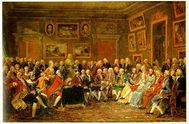

Timeline: 120 minutes (2 class periods)
Unit: IV--An Age of Global Revolutions
Course: World Studies
Grade Level: 10th grade
Objectives: After this lesson, students will be able to:
1. identify the ideas and beliefs of the Enlightenment thinkers.
2. analyze how the emergence of the Enlightenment fits in with the changing values and ideas of the era.
3. explain how the ideas of the Enlightenment thinkers compare and contrast to each other.
Key Concepts and Terms: Enlightenment, Hobbes, Locke, Montesquieu, Rousseau, Wollstonecraft
Intellectual Problem: How do the Enlightenment thinkers reflect the changing values and ideas circulating in Europe?
Standards: MI HSCE 5.3.5
Instructional Sequence:
Activity One: What do you think? “Corners” Activity
1. Humans are naturally selfish.
2. Government is necessary to keep order
3. Without government, the world would be chaotic
4. Giving up some of your rights in exchange for law and order sounds like a good idea
5. The purpose of government is to protect the citizens’ rights
6. If the people do not agree with the government, then the people have the right to rebel and demand change.
7. It is important the power is separated and not given to one person
8. Humans are naturally good
9. All people should be free and equal, without social classes and social hierarchies
10. Education is necessary to become virtuous, useful, and productive
11. Every person should be given an education
12. Some jobs should be filled only by a specific gender.
13. Traditional marriage roles are important to maintain order
14. Through experience, people naturally gain wisdom and insight
15. People know how best to govern their own affairs, not the government.
I will read each statement and prompt students to form their own opinions. Students will go to one side of the room if they agree with the statement and the other side of the room if they disagree. Then, my prompting some students to share their thoughts, this first part of the lesson will encourage discussion and debate about these topics.
Activity Two: Research Enlightenment thinkers
Then, students will be assigned an Enlightened thinker. Students will have the remainder of the class to read about their thinker and to write a summary of their thoughts and ideas. What students don’t finish in class will be homework.
Activity Three: Exploring the Ideas of the Enlightenment
The next day, students will get into groups based on the Enlightened thinker they researched the day before. We will go through the same questions as the day before; however, this time, each group needs to decide whether or not their thinker agrees or disagrees with the statement. Each group needs to be prepared to defend their statements.
Activity Four: Review and Political Spectrum
After we go through each statement, we will go over the main points of each Enlightened thinker. Students should fill in their chart, so they have this information.
Then, we will put each of the thinkers on a Political Spectrum, based on where they fall with their beliefs and ideas about society
Accommodations: Some of these texts are quite advanced and may prove to be a challenge to many of the students (especially those students with learning disabilities centered on reading and writing). To help students overcome these challenges, I am providing students a worksheet and questions to guide their reading.
Assessment: I will be informally assessing students through their responses during the class discussion and review. Similarly, as I will be collecting the students’ homework of their research, I will be able to formally assess students’ understanding of the material.
Technology: The only technology I plan on using during this lesson is the document camera. This is a useful tool that seems to help students follow lectures and take notes more efficiently and effectively.
Materials:
1. Textbook section 22.2
2. John Locke’s Two Treatise on Government
3. Jacques Rousseau’s The Social Contract
4. Mary Wollstonecraft’s A Vindication of the Rights of Woman
5. Thomas Hobbes's Leviathan
To view my reflection of the lesson, click here.